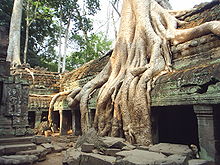 Chennai | Posted on Feb 27, 2012
Chennai | Posted on Feb 27, 2012Indian Express
By V Gangadharan
CHENNAI: One hundred and fifty years after it got the mandate to protect the cultural heritage of the nation, the Archaeological Survey of India (ASI), can have the satisfaction of a job well done. For, it has not only helped in restoration and conservation efforts in many foreign countries, it clearly demonstrated the superior Indian expertise in the field.
It was 2003, when Cambodian authorities requested the ASI’s help to conserve the famous Ta Prohm temple structures without disturbing the over 200-year-old cotton trees that had taken root all around the ancient structure.
When an ASI team led by K T Narasimhan, former Superintending Archaeologist of ASI, Chennai Circle landed in Cambodia, they found that several teams from various countries, including the USA and Japan, were engaged in restoration work in many temple sites but not the Ta Prohm.
The Ta Prohm temple structure complex appeared to be a puzzle for the ASI team. While the structures, intertwined with deep tree roots, had broken in several locations, they were intact in the rest of the complex.
“When I asked [the Cambodian authorities and other experts] if they knew the secret behind the survival of the ancient structure (12th century AD) despite the penetration of such strong roots over 200 years, no one had an answer,” recounts Narasimhan.
When he began his explanation with a Sanskrit verse ‘Silantam va Sikatantam’ the experts were baffled.
“I told them that the secret lay in the foundation. Manasara, an ancient Sanskrit treatise on civil engineering, asserts that to ensure a strong foundation in a soil type inappropriate for construction, boulders or river sand should be used to isolate the structure.”
Obviously, the Cambodian structure must have followed this ancient principle, Narasimhan felt. “As head of the ASI team, I had found that the Darasuram World Heritage site’s structures too had followed a similar principle.”� In Darasuram, the structure was built on heavy boulders to isolate the structure from the influence of the undercurrents of the River Arasalaru.
“Besides the Cambodians, people from the United States were not convinced about ancient Indian wisdom. But, when I dug trenches they were shocked to find that river sand of one metre thickness was used. The entire load was isolated from the peripheral area through this technique,” Narasimhan says.
Stunned by the ASI team’s expertise, the Cambodian authorities wanted recommendations and Narasimhan prepared a 500-page report suggesting what he called an ‘organic and inorganic harmony route’ to protect the ancient structure.
It would be no exaggeration to say that the UNESCO-assisted conservation effort began with the ASI report.
Similarly, in Vietnam’s Da Nang province, ASI offered guidance and support to restore 84 ancient monuments and temple structures that were ravaged during the War.
In France, Narasimhan recalls, a long-time seepage problem in the main wall of the famous Saint Antoine Church was fixed.
By V Gangadharan
CHENNAI: One hundred and fifty years after it got the mandate to protect the cultural heritage of the nation, the Archaeological Survey of India (ASI), can have the satisfaction of a job well done. For, it has not only helped in restoration and conservation efforts in many foreign countries, it clearly demonstrated the superior Indian expertise in the field.
It was 2003, when Cambodian authorities requested the ASI’s help to conserve the famous Ta Prohm temple structures without disturbing the over 200-year-old cotton trees that had taken root all around the ancient structure.
When an ASI team led by K T Narasimhan, former Superintending Archaeologist of ASI, Chennai Circle landed in Cambodia, they found that several teams from various countries, including the USA and Japan, were engaged in restoration work in many temple sites but not the Ta Prohm.
The Ta Prohm temple structure complex appeared to be a puzzle for the ASI team. While the structures, intertwined with deep tree roots, had broken in several locations, they were intact in the rest of the complex.
“When I asked [the Cambodian authorities and other experts] if they knew the secret behind the survival of the ancient structure (12th century AD) despite the penetration of such strong roots over 200 years, no one had an answer,” recounts Narasimhan.
When he began his explanation with a Sanskrit verse ‘Silantam va Sikatantam’ the experts were baffled.
“I told them that the secret lay in the foundation. Manasara, an ancient Sanskrit treatise on civil engineering, asserts that to ensure a strong foundation in a soil type inappropriate for construction, boulders or river sand should be used to isolate the structure.”
Obviously, the Cambodian structure must have followed this ancient principle, Narasimhan felt. “As head of the ASI team, I had found that the Darasuram World Heritage site’s structures too had followed a similar principle.”� In Darasuram, the structure was built on heavy boulders to isolate the structure from the influence of the undercurrents of the River Arasalaru.
“Besides the Cambodians, people from the United States were not convinced about ancient Indian wisdom. But, when I dug trenches they were shocked to find that river sand of one metre thickness was used. The entire load was isolated from the peripheral area through this technique,” Narasimhan says.
Stunned by the ASI team’s expertise, the Cambodian authorities wanted recommendations and Narasimhan prepared a 500-page report suggesting what he called an ‘organic and inorganic harmony route’ to protect the ancient structure.
It would be no exaggeration to say that the UNESCO-assisted conservation effort began with the ASI report.
Similarly, in Vietnam’s Da Nang province, ASI offered guidance and support to restore 84 ancient monuments and temple structures that were ravaged during the War.
In France, Narasimhan recalls, a long-time seepage problem in the main wall of the famous Saint Antoine Church was fixed.

No comments:
Post a Comment